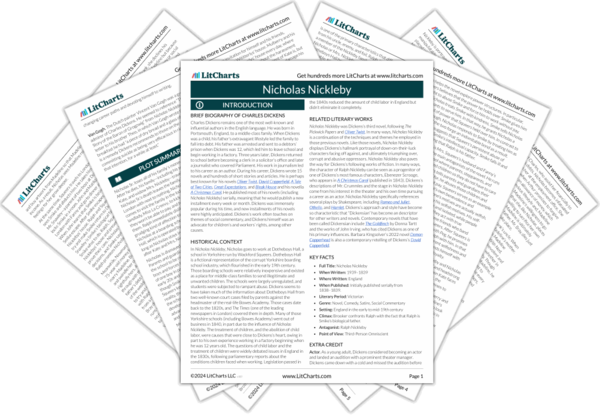Welcome to the LitCharts study guide on Charles Dickens's Nicholas Nickleby. Created by the original team behind SparkNotes, LitCharts are the world's best literature guides.
Nicholas Nickleby: Introduction
Nicholas Nickleby: Plot Summary
Nicholas Nickleby: Detailed Summary & Analysis
Nicholas Nickleby: Themes
Nicholas Nickleby: Quotes
Nicholas Nickleby: Characters
Nicholas Nickleby: Symbols
Nicholas Nickleby: Literary Devices
Nicholas Nickleby: Theme Wheel
Brief Biography of Charles Dickens

Historical Context of Nicholas Nickleby
Other Books Related to Nicholas Nickleby
- Full Title: Nicholas Nickleby
- When Written: 1939–1839
- Where Written: England
- When Published: Initially published serially from 1838–1839.
- Literary Period: Victorian
- Genre: Novel, Comedy, Satire, Social Commentary
- Setting: England in the early to mid-19th century
- Climax: Brooker confronts Ralph with the fact that Ralph is Smike’s biological father.
- Antagonist: Ralph Nickleby
- Point of View: Third-Person Omniscient
Extra Credit for Nicholas Nickleby
Actor. As a young adult, Dickens considered becoming an actor and landed an audition with a prominent theater manager. Dickens came down with a cold and missed the audition before changing career paths and devoting himself to writing.
Van Gogh. The Dutch painter Vincent Van Gogh was a great admirer of Charles Dickens. He seemed to reference “The Story of the Baron of Grogzwig” from Nicholas Nickleby in a letter to his brother Theo, in which Van Gogh wrote that for breakfast he had “a piece of dry bread and a glass of beer—that is a remedy Dickens recommends to those on the verge of committing suicide as being very efficacious in ridding them of that intention, for a while at least.”







